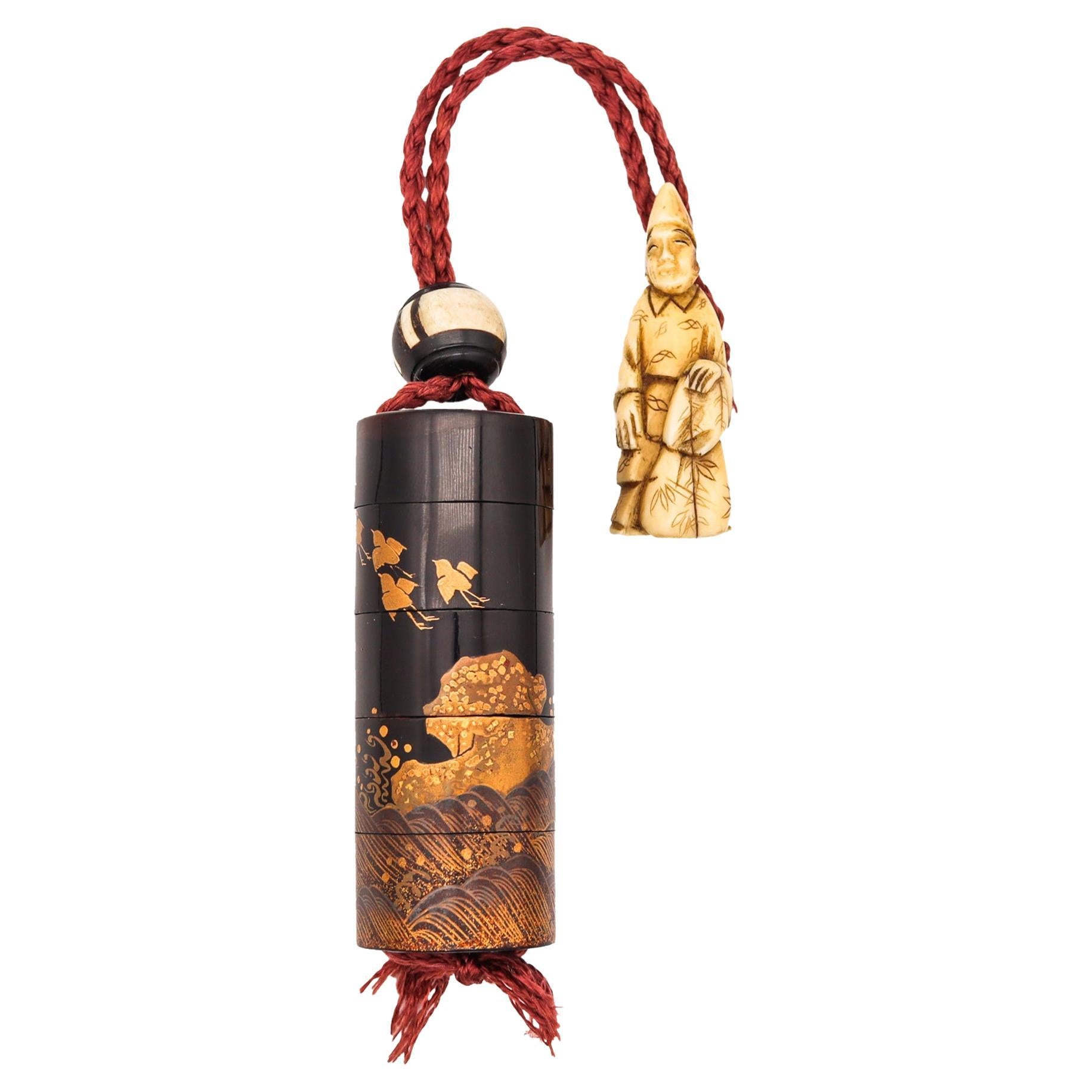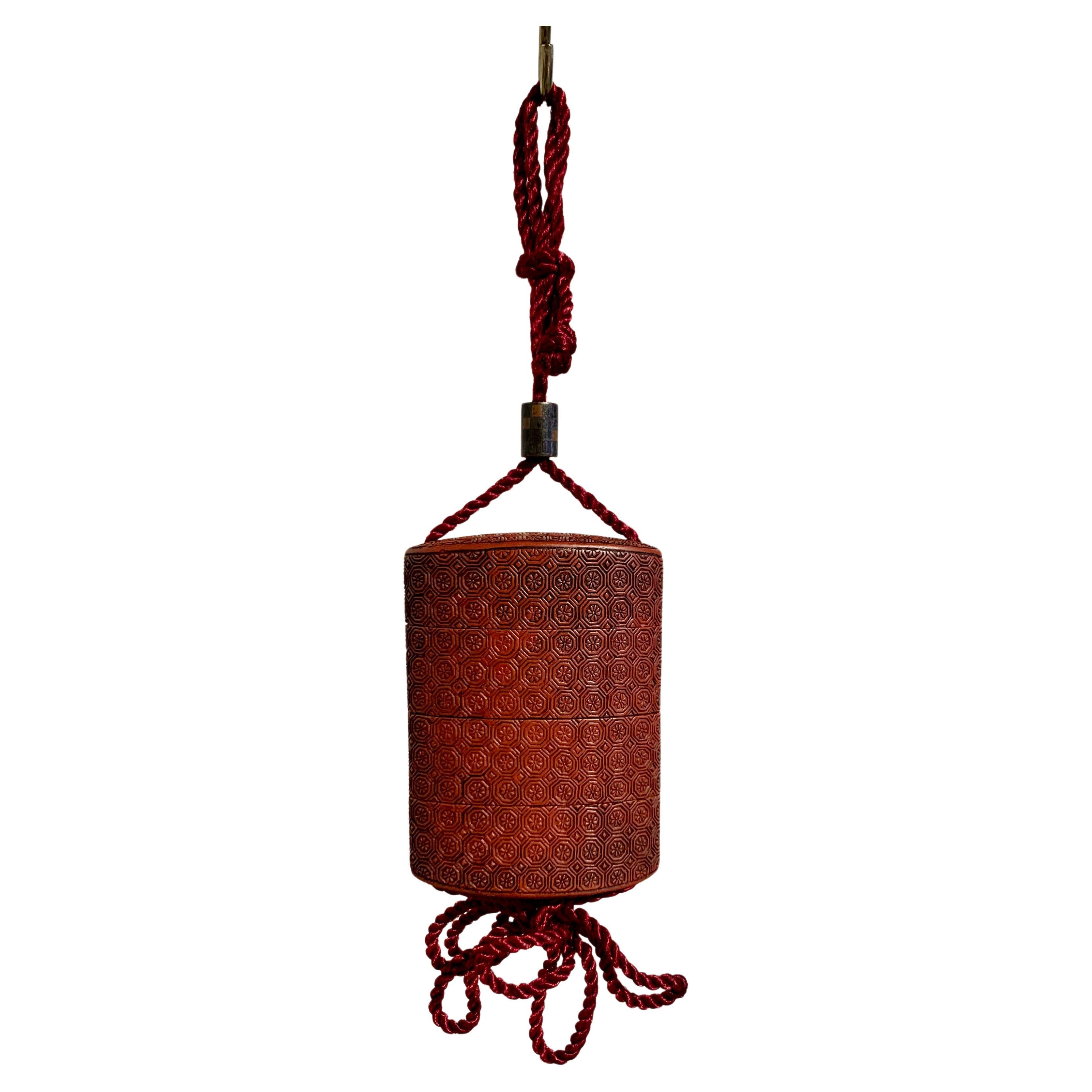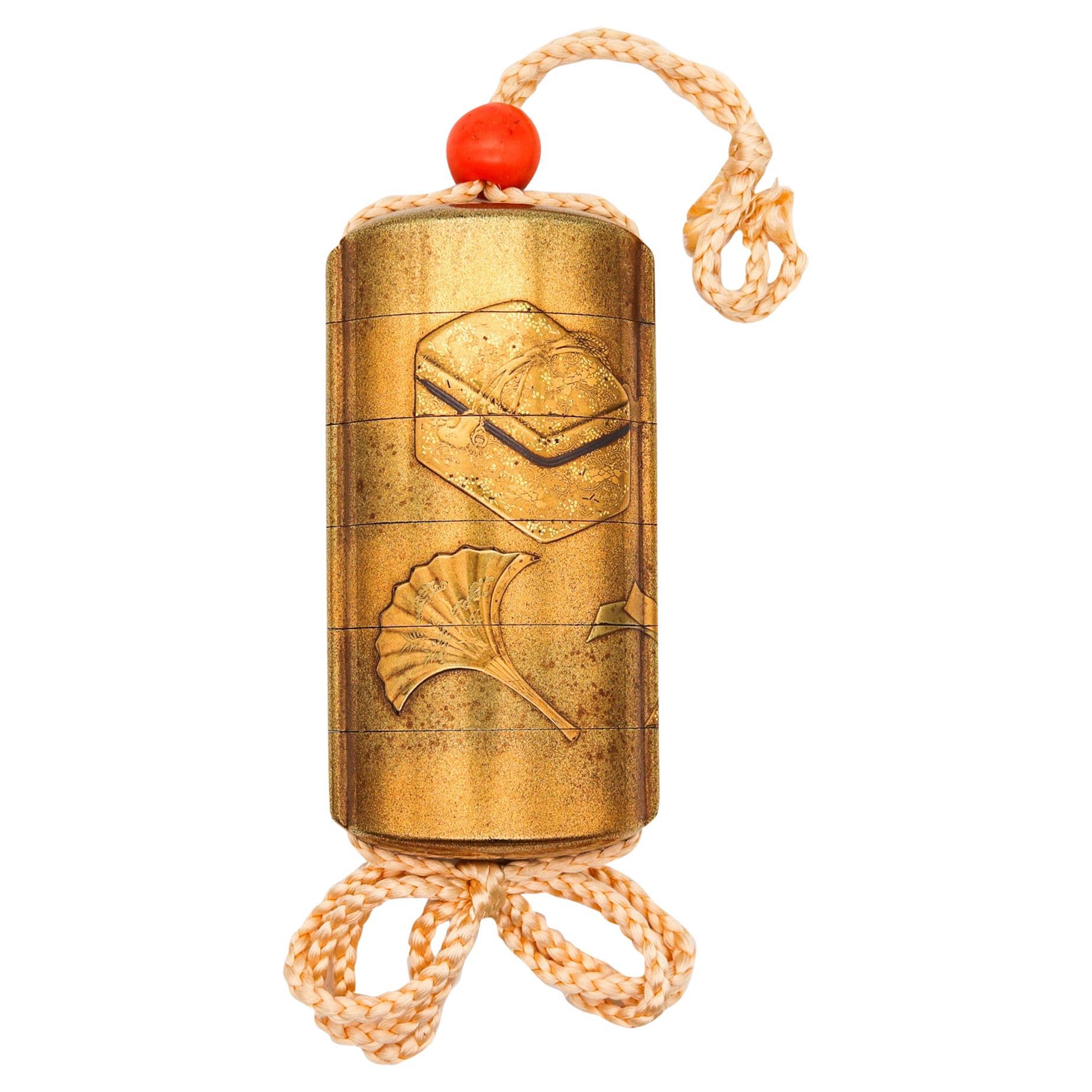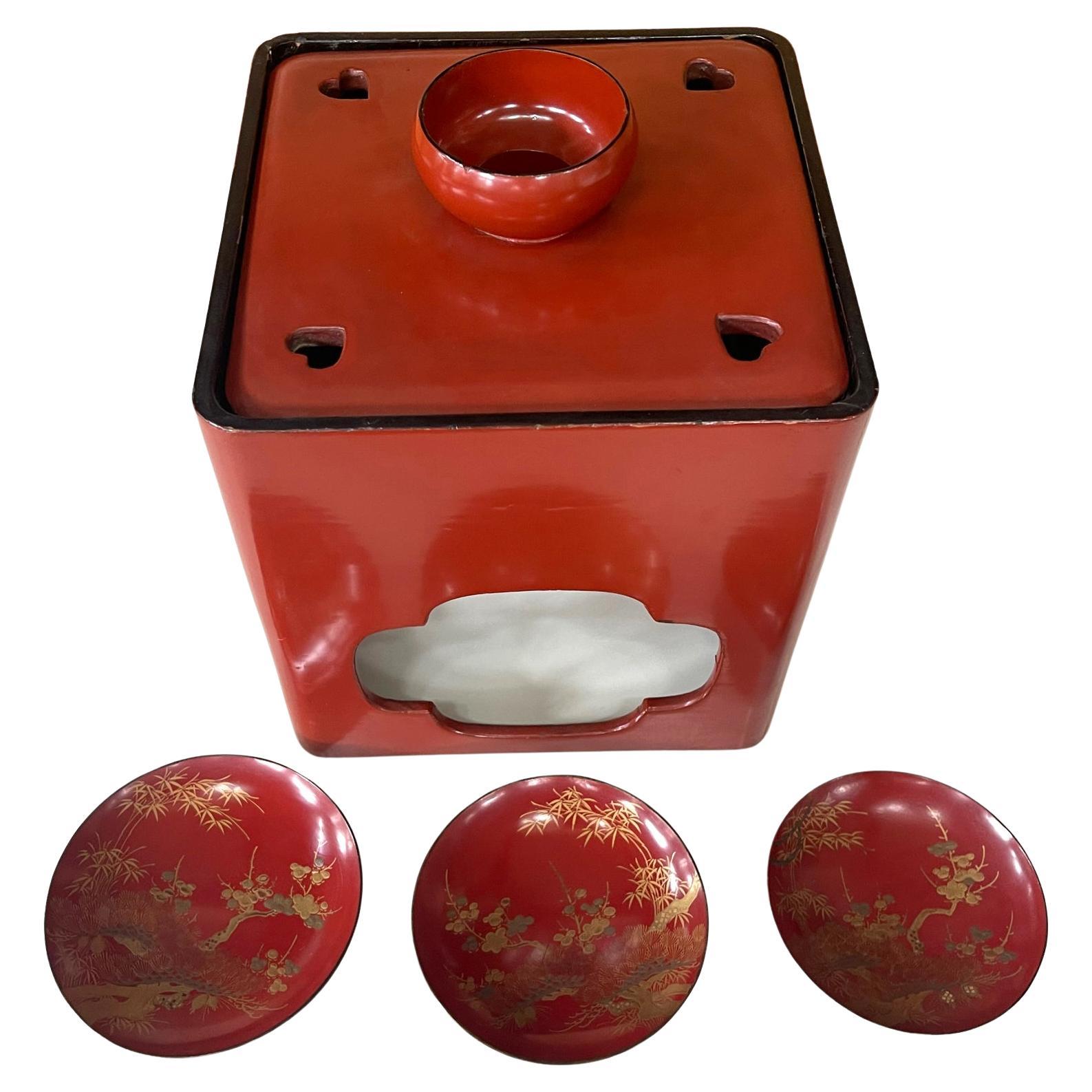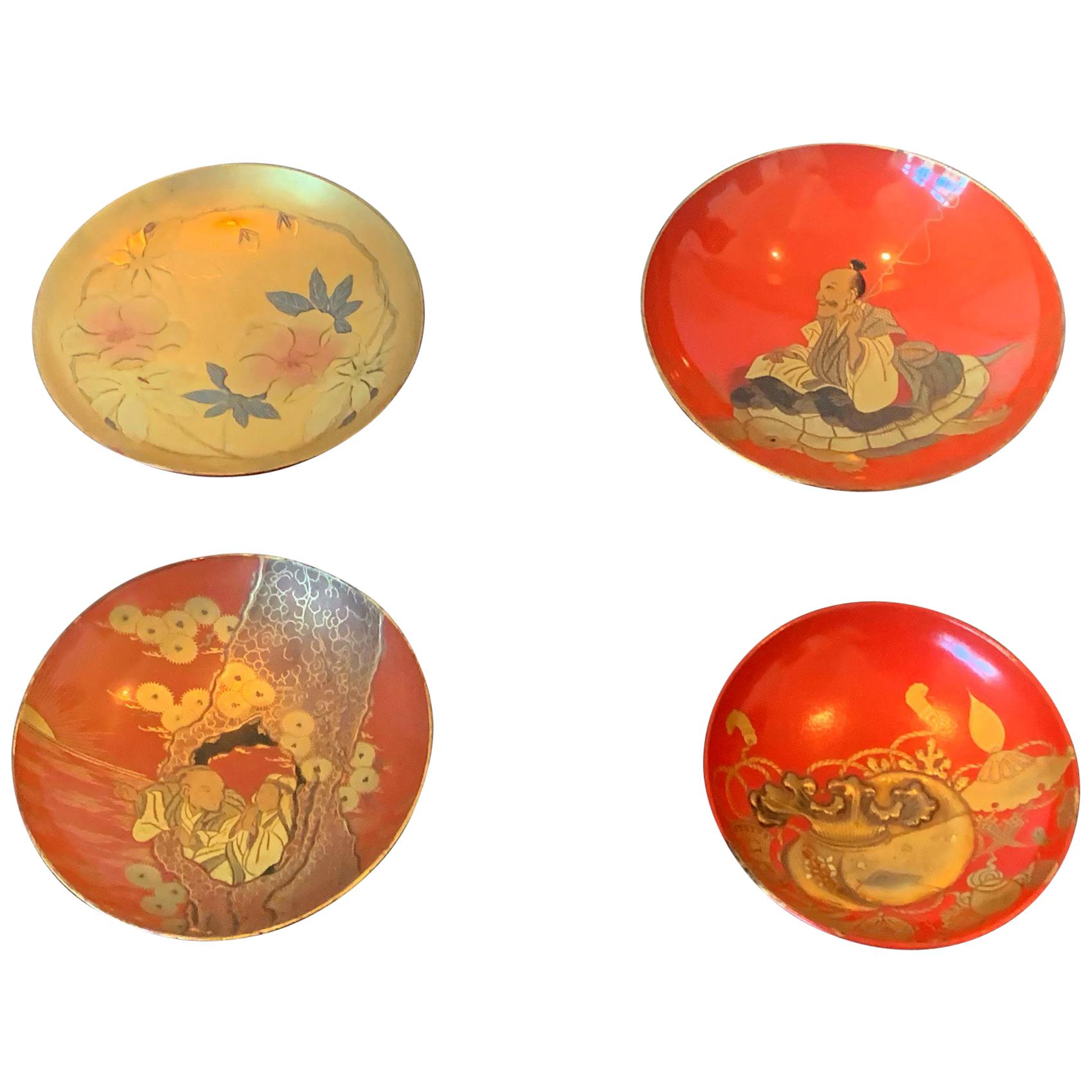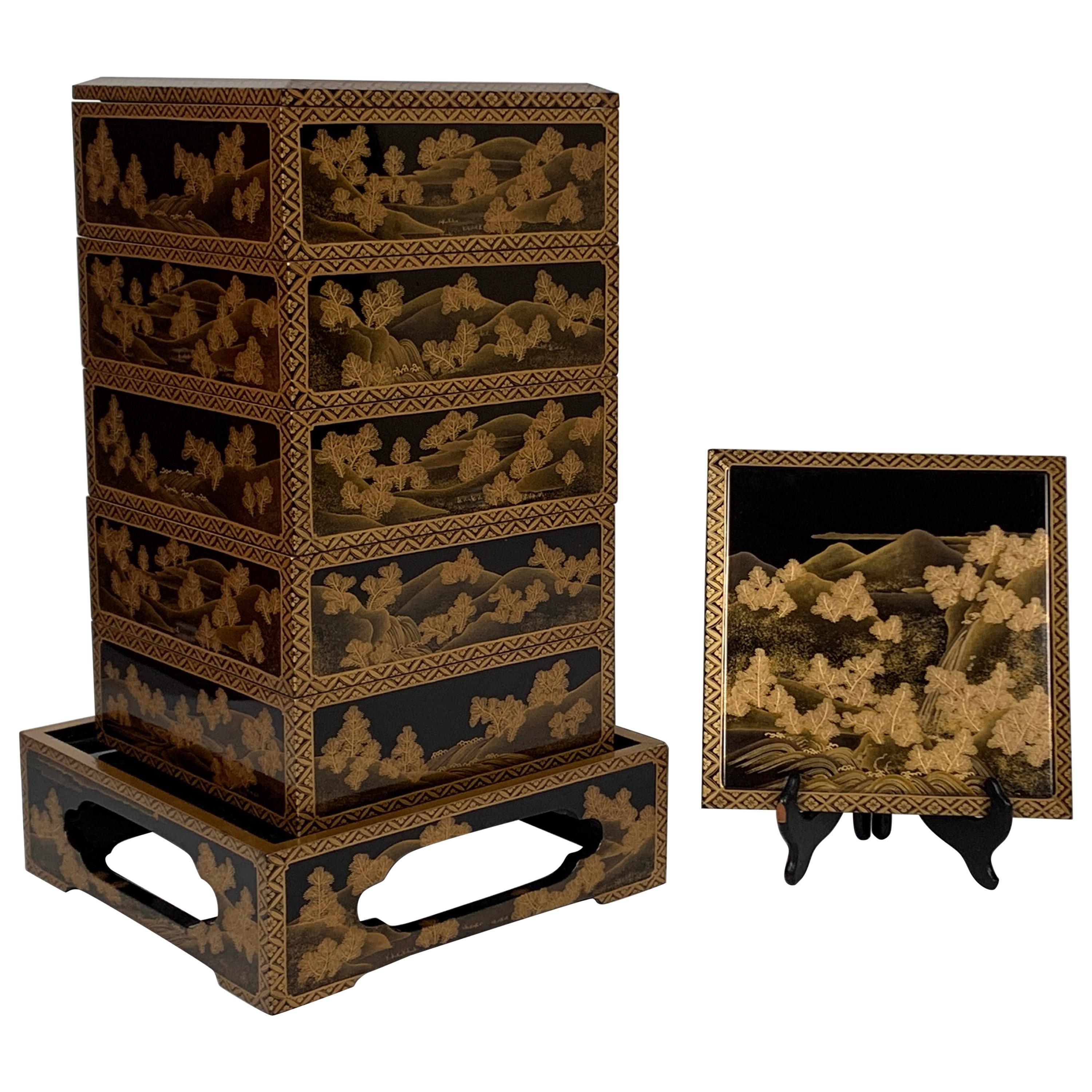Items Similar to Japanese Meiji Period Lacquer Six Drawer Inro
Want more images or videos?
Request additional images or videos from the seller
1 of 18
Japanese Meiji Period Lacquer Six Drawer Inro
About the Item
The Inro is decorated with a gold lacquer base and features mother of pearl shell inlay leaves surounding wheeled cart with foliage. The Inro with a slide action opening which hides six silver handled drawers. The Inro dates to the Meiji Period (1868-1912) circa 1885.
Meiji Period was an era of Japanese history that spanned from 1868 to 1912. It was the first half of the Empire of Japan, when the Japanese people began to build a paradigm of a modern, industrialised nation state and emergent great power, influenced by Western countries and aesthetics. As a result of radically different ideas, the changes to Japan were profound and it affected the social structure, politics, economy, military, and foreign relations across the board. The period corresponded to the reign of Emperor Meiji and was preceded by the Keio era and was succeeded by the Taisho era.
Cultural Art during the Meiji Period was of particular interest to the government and they overhauled the art export market which in turn promoted Japanese arts via various world’s fairs, beginning in Vienna at the world fair in 1873. The government heavily funded the fairs and took an active role organising how Japan’s culture was presented to the world including creating a semi-public company named Kiritsu Kosho Kaisha (First Industrial Manufacturing Company). The Kiritsu Kosho Kaisha was used to promote and commercialise exports of Japanese art and established the Hakurankai Jimukyoku (Exhibition Bureau) to maintain quality standards. For the 1876 Centennial International Exhibition in Philadelphia, the Japanese government created a Centennial Office and sent a special envoy to secure space for the 30,000 items that would be displayed. The Imperial Household also took an active interest in arts and crafts, commissioning works by select artists to be given as gifts for foreign dignitaries further emphasising the high quality and importance of Japanese art. Just before the end of the 19th century in 1890, the Teishitsu Gigeiin (Artist to the Imperial Household) system was created to recognise distinguished artists. These artists were selected for their exceptionally high quality wares and talent in their own industry. Over a period of 54 years Seventy artists were appointed, amongst these were ceramicist Makuzu Kozan and cloisonné enamel artist Namikawa Yasuyuki.
Mother of Pearl is an organic–inorganic composite material produced by some molluscs as an inner shell layer. It is the same material that natural pearls are made from and is desirable due to its strong and resilient makeup along with its beautiful iridescent shimmer.
Measurements (centimetres) 7.3cm High x 6.7cm Wide x 2.4cm Deep
- Dimensions:Height: 2.87 in (7.29 cm)Width: 2.64 in (6.71 cm)Depth: 0.94 in (2.39 cm)
- Style:Meiji (Of the Period)
- Materials and Techniques:
- Place of Origin:
- Period:
- Date of Manufacture:Circa 1885
- Condition:Wear consistent with age and use.
- Seller Location:Newark, GB
- Reference Number:
About the Seller
5.0
Vetted Seller
These experienced sellers undergo a comprehensive evaluation by our team of in-house experts.
Established in 2019
1stDibs seller since 2022
17 sales on 1stDibs
Typical response time: 3 hours
- ShippingRetrieving quote...Ships From: Newark, United Kingdom
- Return PolicyA return for this item may be initiated within 14 days of delivery.
More From This SellerView All
- Japanese Meiji Period Satsuma Bowl KinkozanBy KinkozanLocated in Newark, EnglandFrom our Japanese collection, we are delighted to offer this Japanese Meiji period Satsuma Bowl by Kinkozan. The earthenware bowl with pinched rim extensively decorated on both the exterior and interior. The bowl with a cobalt blue base glaze decorated to the borders with gilt shippo-tsunagi (linked-cash) with scattered medallion roundells. Around the exterior two elongated scenes are featured, one with boys playing games in a courtyard with the other featuring seated scholars in full dress both with raised enamel decoration. The interior features a central scene with Samurai warriors in training fully armoured with swords in a courtyard with landscapes scenes to the background. The central scene bordered by further stylised shippo-tsunagi type decoration with a greek key rim border. The bowl signed to the base Kinkozan dating to the Meiji Period (1868-1912) circa 1900. Shippo-Tsunagi (linked-cash) or seven treasures, is a traditional Japanese geometric pattern that combines four ellipses in a circle. These ellipses repeat outward to then create more circles, symbolising eternal peace and happiness. Kinkozan the Kinkozan family have been associated with pottery dating back to 1645. They went on to become the largest producer of Satsuma ware by one individual company, from the end of the 19th century until 1927 after which the factory closed. By the 1850s Kobayashi Sobei (1824-84), Kinkozan Sobei...Category
Antique Early 1900s Japanese Meiji Ceramics
MaterialsCeramic, Earthenware, Pottery, Faux Leather
- Antique Japanese Meiji Period Iron BoxLocated in Newark, EnglandMeiji Period (1868-1912) From our Japanese collection, we are delighted to offer this Antique Japanese Meiji Period Iron Box. The Box of slim rectangular form cast in iron and raise...Category
Antique 1890s Japanese Meiji Metalwork
MaterialsSilver, Enamel, Iron
- Japanese Bronze Vase Pair Meiji PeriodLocated in Newark, EnglandA fine large sized pair of Japanese bronze vases. The vases each surmounted by waisted necks flanked by two spreading handles with accents in the form of Japanese Torri (traditional ...Category
Antique Late 19th Century Japanese Meiji Metalwork
MaterialsMetal, Gold, Silver, Bronze, Copper
- Japanese Meiji Period Satsuma Floor VasesLocated in Newark, EnglandThe vases of large oval form potted from earthenware with pinched neck and base stood upon a splayed circular foot. The vases extensively decorated with a continuous scene with polychrome colours and raised enamels featuring a large central white elephant and various figures. The top and bottom bordered by arched gilt decoration and gilded rims. The bases signed by a three character mark in red 新井造 Arai Zo (made by Arai). The vases date to the Meiji period (1868-1912) and are large in size measuring 46cm High. Meiji Period is an era of Japanese history that spanned from 1868 to 1912. It was the first half of the Empire of Japan, when the Japanese people began to build a paradigm of a modern, industrialised nation state and emergent great power, influenced by Western countries and aesthetics. As a result of radically different ideas, the changes to Japan were profound and it affected the social structure, politics, economy, military, and foreign relations...Category
Antique Late 19th Century Japanese Meiji Vases
MaterialsCeramic, Earthenware
- Japanese Bronze Torii Gate Sculpture Meiji PeriodLocated in Newark, EnglandBeautifully sculpted Japanese Meiji period Torii gate sculpture. The sculpture made from solid bronze with a beautiful patination throughout dating to the Meiji period 1868-1912 circa 1890. The gate of traditional form representing the Matsuo Shrine in Kyoto. The characters read ???? translated directly to Matsuo Shrine. Notes The Torii gate sculpture was crafted after the famous Torii gate which is found in the Arashiyama district in Kyoto. It houses Matsuno’o Taisha (Matsunoo Taisha ????) one of the oldest shinto shrines in Kyoto dating to 701, approximately 100 years before the city of Kyoto. It boarders the mountains and has a distinct main hall dating to 1397 which is also one of the oldest buildings in the city of Tokyo. The shrine’s spring is famous for its restorative properties and sake and miso producer’s patron the shrine with their particular industries relying on the pure water to survive. The distinct giant Torri gate stands at 14 meters tall alluding to its significance in the city. Three beautiful gardens can...Category
Antique Late 19th Century Japanese Meiji Sculptures and Carvings
MaterialsBronze
- Japanese Meiji Period Koi Carp Bronze BoxLocated in Newark, EnglandJapanese meiji period mixed metal box. The box formed in a kidney shape decorated with swimming koi carp fish throughout. Each koi with intricate detailing wi...Category
Antique Early 1900s Japanese Meiji Metalwork
MaterialsMetal, Gold, Bronze
You May Also Like
- Japan 1870 Meiji Period Round Five Drawer Inro Lacquered Wood With Flying CranesLocated in Miami, FLJapanese Inro from the Meiji Period (1868-1912). Beautiful Inro, created in Japan during the Meiji imperial period, circa 1870. It was carefully crafted in carved precious wood with...Category
Antique 1870s Japanese Meiji Lacquer
MaterialsGiltwood, Lacquer, Wood, Ebony
- Japanese Carved Cinnabar Lacquer Inro, Meiji Period, late 19th c, JapanLocated in Austin, TXA good Japanese carved cinnabar three case inro with mixed metal ojime, Meiji period, late 19th century, Japan. The three case inro of standard form, comprised of three container se...Category
Antique Late 19th Century Japanese Meiji Lacquer
MaterialsSilver, Copper
- Japan 1800 Edo Period Six Drawer Inro In Lacquered Gilt Wood With UtensilsLocated in Miami, FLJapanese Inro from the Edo Period (1603-1867). Beautiful Inro, created in Japan during the Edo period (Shogunate), circa 1800. It was carefully crafted in carved precious wood with ...Category
Antique Early 1800s Japanese Edo Lacquer
MaterialsCoral
- Japanese Lacquered Sake Drinking Set Meiji PeriodLocated in Atlanta, GAA Japanese lacquered Sake Drinking set circa late 19th century (end of Meiji period), The assemble consists of a red lacquer stand open frame support and a lid that encloses a storage space with black lacquered interior. The lid features a and a cup holder in the center and four heart shape cutouts on the corners. There are three maki-e decorated sake cups with gradual sizes. The cups showcase on the red background elaborate gold hiramaki-e paintings...Category
Antique Late 19th Century Japanese Meiji Lacquer
MaterialsWood, Lacquer
- Four Japanese Lacquered Sake Cups Meiji PeriodLocated in Atlanta, GAAn assemble of four lacquerware sake cups from Meiji period Japan circa late 19th century. The shadow cups on an elevated stem were used by the nobles during ...Category
Antique Late 19th Century Japanese Meiji Lacquer
MaterialsWood, Lacquer
- Japanese Maki-e Lacquer Stacking Box, Jubako, Meiji Period, JapanLocated in Austin, TXA fine and impressive Japanese gold maki-e decorated black lacquer five-tier jubako with presentation tray, two lids, and the original tomobako storage box, Meiji period, late 19th c...Category
Antique Late 19th Century Japanese Meiji Lacquer
MaterialsLacquer
Recently Viewed
View AllMore Ways To Browse
Southeast Asian Pearls
Art Deco Onlay
Takasago Couple
Lacca Giapponese
Negoro Nuri
Giant Silver Tray
Black And Gold Lacquer Chinese Miniature Chests
Japanese Lacquer Box Calligraphy
Japanese Lacquer Art
Mother Of Pearl Japan
Metal Netsuke
Japanese Meiji Period Silver Kodansu
Large Natural Shells
Steel Wall Lights Pair
Vintage Three Seat Sofas Seating
Solid Wood Display Cabinet
Apple Lighting
Mid Century Danish Dining Chairs Leather
